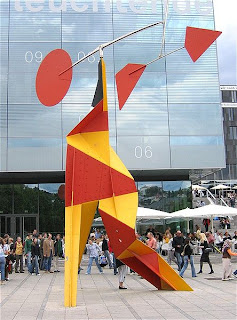Surrealism is a cultural movement that began in the early 1920s, and is best known for its visual artworks and writings.
Surrealist works feature the element of surprise, unexpected juxtapositions and non sequitur; however, many Surrealist artists and writers regard their work as an expression of the philosophical movement first and foremost, with the works being an artifact. Leader André Bretonwas explicit in his assertion that Surrealism was above all a revolutionary movement.
Surrealism developed out of the Dada activities during World War I and the most important center of the movement was Paris. From the 1920s onward, the movement spread around the globe, eventually affecting the visual arts, literature, film, and music of many countries and languages, as well as political thought and practice, philosophy, and social theory.
Surrealism has come to be seen as the most influential movement in twentieth century art. Figures like Salvador Dalí and Man Ray not only had an important influence on avant-garde art, but through their commercial work - in fashion photography, advertising and film - they brought the style to a huge popular audience. Following the demise ofMinimalism in the 1960s, the movement's influence also returned to art, and since the 1970s it has attracted considerable attention from art historians.
Surrealism was officially founded in 1924, when André Breton wrote Le Manifeste du Surréalisme. In it, he defined Surrealism as "Psychic automatism in its pure state, by which one proposes to express - verbally, by means of the written word, or in any other manner - the actual functioning of thought." In this, he proposed that artists should seek access to their unconscious mind in order to make art inspired by this realm.Initially a literary movement, many Surrealists were ambivalent about the possibilities of painting, however, the group's leader, André Breton, later embraced and promoted painting. The work of Surrealist painters such as Joan Miró would be an important influence on the Abstract Expressionists in the 1940s.
Artist => Salvador Dali
(Persistence of Memory)
Dalí was a skilled draftsman, best known for the striking and bizarre images in his surrealist work. His painterly skills are often attributed to the influence of Renaissance masters.
Library Source => "Surrealism and the Visual Arts-Theory and Reception"/ Kim Grant
"Breton situated the Surrealist project in the territory of the mind, and, more importantly, on the terrain of "real" mental functioning prior to rationality, morality, aesthetics, or practical application. This project is an attempt to capture and "express" thought prior to all imposed systems; fundementally, it is an effort to gain access to the true lyrical language. The ultimate goal, however, is not mere self-expression but the resolution of the "principal problems of life," the transformation of the world by resolving dream and reality into a surreality. It is this goal of transformation, the resolution of mind and matter, that will form the solid basis for a Surrealist theory of visual art." (pg 75-76)
"The Bulletin's description of Surreailst art as the naturalistic representation of heterogeneous objects reflected a theoretical understandingmore than a consideration of actual Surrealis works." (pg 174)
"The Surrealists' renewed dedication to the concrete transformation of reality evident in the Second Manifesto was reflected in their new review, Le Surrealisme au Service de la Revolution , which began publication in the summer of 1930. As its title indicates, Surrealism was now proposed as an instrument for revolution, a revolution that was by implication communist, but was in fact more properly conceived as a total reorganization of human reality. The review was even less like an art magazine in its appearance than its predecessor. It had very few images, and those it published were placed in the back of the issue rather than interspersed throughout the magazine as illustrations. Only one painting was partially reproduced in the first issue, Dali's invisible Man, which served as a demonstration of Dali's theory of paranoia outlined in "L'ane pourri" This was the only full-length article that addressed visual art in the first two issues of the magazine." (pg 288)






















